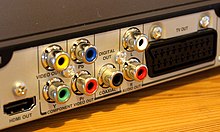Component video
Component video , often referred to as component or component input / output , was used in the 1990s and early 2000s for the high-quality transmission of video signals from DVD players and early HDTV receivers to the corresponding display devices (mostly tube screens or projectors ) is used. In the history of development, it stands between Scart RGB connections and the following digital connections. In contrast to Scart-RGB, colors are transmitted as color difference signals (mostly with full bandwidth). In addition to the formats 480i60 and 576i50, which are compatible with the NTSC and PAL television standards, progressive SDTV and HDTV formats are also permitted.
YPbPr is the analog version of the digital YCbCr with which u. a. the video data stored on the DVD and the video data transmitted via satellite, cable or antenna with DVB are color-coded. Since the conversion from digital YCbCr to analogue YPbPr takes place without any loss of information due to conversion, component video, along with progressive RGB, represents the most suitable analogue connection and signal form for the transmission of video signals from the DVD player or DVB receiver to the display device.
The YPbPr signal used in component video consists of the brightness signal “Y” and the color deviation signals “Pb” for the deviation from gray on a blue-yellow scale and “Pr” for the deviation from gray on a red-turquoise scale. The synchronization signal does not need its own line, but is contained in the brightness signal "Y".
Connection and connector variants

Most of the time, and especially in the home theater sector, the signal was transmitted via three separate cinch cables, in high-quality systems also BNC . It is also possible to transmit the component video signals instead of the RGB signals via a Scart connection; Devices that are capable of doing this have i. d. Typically a choice in their settings menu. The D-terminal connection is also common in Japan .
With modern computer graphics cards , component video is made available via a 9-pin mini-DIN socket known as “S-Video” or “TV Out” . Usually these cards come with an adapter for component cinch, composite cinch and 4-pin S-video . Alternatively, a 7-pin mini-DIN socket can be used; this connection also supplies YPbPr in addition to the S-video signals in some cases. The 4-pin S-video connector also fits into the seven-pin coupling. However, since these mini-DIN connection options do not correspond to any standard, one should not assume that component signals will always be output there.
The component video connection only transmits video signals. Due to the available transmission capacity, it is possible with the analog interface to transmit resolutions up to 1080p. However, under the pretext of copy protection measures, it is often no longer allowed to transport video signals of such high quality unprotected, so for higher HD resolutions one is forced to use the encryptable digital interface HDMI .
Tapping the analog, uncompressed component video stream would no longer be practicable anyway, since it is possible to receive an unencrypted HD signal via "defective" devices. Decryption of the HD signal has recently been made significantly easier by the discovery of the HDCP master key.
Compared to YUV
Component video is now an outdated variant of the transmission of video signals, which partially replaced the previous transmission variants composite video (FBAS) and S-video - i. H. Receiving, recording and playback devices use internally instead of YUV - (with PAL ) or YIQ - color-coded (with NTSC ) analog processes, YCbCr -color-coded digital processes. Nevertheless, the component video signal is often incorrectly referred to as YUV in various on-screen menus and test reports.
Compared to RGB video
Contrary to what was sometimes expected, component video did not replace the RGB signal for video recording and television transmission in the analog area either, as that would be more complex. For technical reasons, the display on screens and projectors is controlled exclusively by means of RGB signals (structure of the displayed image from red, green and blue color components). These are calculated from YCbCr (digital, e.g. DVD-Video or DVB television) or YPbPr (analog component video cable), either already in the receiver / playback device (so that the video data, e.g. via HDMI or DVI , already RGB-coded can be transmitted to the display device) or only in the display device itself (so that YCbCr, for example via HDMI or i.Link , or YPbPr is transmitted via component video).
Web links
Individual evidence
- ↑ sites.google.com/site/hdcontentsecurity ( English) ( Memento from October 9, 2009 in the Internet Archive )
- ↑ hackaday.com/2010/09/24/the-hdcp-master-key (English)
